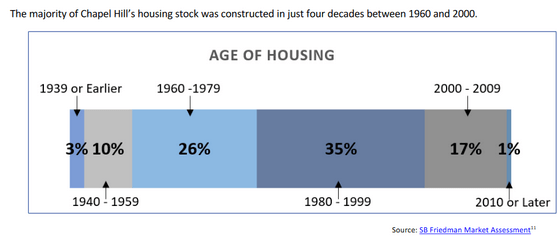Earlier this week The Guardian published an article on the transformation of some of Durham’s naturally occurring affordable housing (NOAH) into million dollar McMansions.
The article does a good job of pointing out that there is a huge inflow of demand – Durham has grown by 20% since 2010, driven by the boom of good jobs. This attracts new people from out of state to this region while encouraging existing residents to stick around. New residents have come from places like DC, New York, and California, where homes are typically more expensive than in North Carolina. Some of these new residents are buying small homes, tearing them down, and building much larger single family homes in their place.
In Chapel Hill, we see the same thing happening. Single family homes in older neighborhoods are being torn down and replaced by bigger and more expensive homes. Older houses are relatively affordable to purchase because their costs had been amortized – they had been built fifty, sixty, seventy, eighty years ago – and many older homes are not in great condition. They have been knocked down and replaced by bigger and much more expensive houses.
A systematic demand challenge
Chapel Hill faces the same systemic demand challenge that the Guardian article describes in Durham. Lots of people want to live here because there are a lot of new, well-paying jobs in the region. The town offers attractive amenities, like high performing schools and ample greenspace. Folks with more money will frequently outbid folks with less money to live in town. And, as RTP grows and transforms into a larger tech hub than it is today, more people with more money are going to want to live in Chapel Hill.
This naturally puts pressure on home prices to increase. Under current zoning rules, there is nothing that Chapel Hill can do to restrict an upper income buyer from buying an older, affordable unit, tearing it down, and putting up a McMansion (not to mention tearing down an older, expensive home – a $1.6 million single family home was recently demolished to make way for a $2.7 million single family home).
We expect this to happen more and more as more homes in Chapel Hill reach the end of their lifespan. The majority of our housing stock was built between 1960 and 2000. Some of those older homes have structural problems. It is likely that teardowns will become more common, as they have in other places around the country when houses reach 50, 60, 70, 80 years old.

Under the towns’ Housing Choices proposal, there is still nothing preventing teardowns from becoming McMansions. But there is an opportunity to turn them into duplexes, which will incrementally relieve some of the incredible demand pressures on the housing market that have substantially driven up local prices.
Thinking about how Chapel Hill can evolve to fit the future needs of all of our residents is a big question. But it’s one we must contemplate as our housing stock ages. Must we always have the exact same footprint as we do now? Or does slightly changing our footprint – by allowing two new units to replace one older unit that will be torn down regardless of whether or not we allow duplexes – give us an opportunity to create something better?